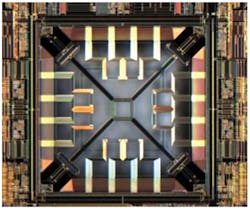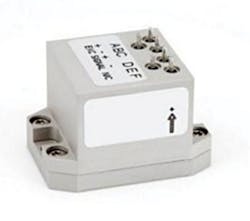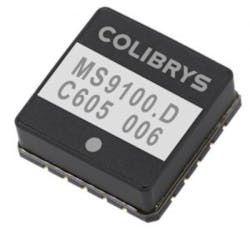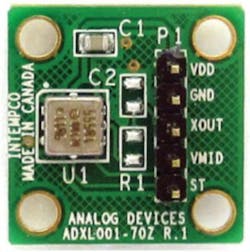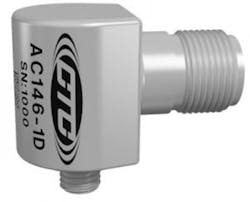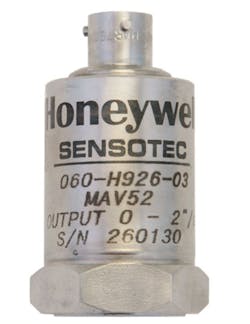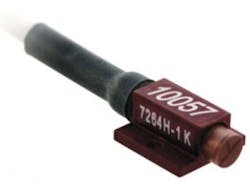Anyone who has performed vibration tests is familiar with accelerometers, which are positioned on the EUT to measure the acceleration relative to the shaker and, most importantly, to find resonances. Several technologies have been developed to address almost any application and include MEMS-based approaches as well as those that use piezoelectric and piezoresistive effects. There even are accelerometers based on eddy-current measurement.
The AAA545 series of solid-state accelerometers measures vector acceleration over the range of ±2g to ±500g with ≤0.5% FRO nonlinearity and ≤2-mV offset. The devices incorporate a micromachined piezo-resistive strain gauge bridge silicon sensor with air damping. Unlike fluid damping, the air damping employed is essentially independent of temperature. The transducer also has positive mechanical stops for shock resistance.
Designed for operation from an unregulated DC power source, the AAA545 is packaged in an aluminum alloy housing with solder-pin connections. Frequency response is from DC to 250 Hz for the ±2g model, increasing to DC to 2,400 Hz for the ±500g model. Altheris Sensors and Controls
Model MS9000 sensors are MEMS capacitive accelerometers developed for precision inertial systems for land, sea, and air applications. With a dynamic range of ±2g to ±200g, they are part of the exclusive group of MEMS used in European Aviation Safety Agency, FAA, and Design Assurance Level A certified systems.
This single-axis analog accelerometer is based on bulk micro-machined silicon elements specifically designed for high bias stability over temperature in harsh environments. The product embeds a low-power ASIC (0.5 mA) and a temperature sensor and is fully calibrated. The robust, hermetically sealed LCC20 ceramic package insures long-term stability.
Key features for the ±10g range include low bias and scale factor TC < ±0.5mg/°C (typ.) and 300 ppm/°C (typ.), a reference for one year bias stability <±1.5mg (typ.), and high resolution <0.15mg (typ.). Colibrys
The MXP7205VF is a low-cost, dual-axis thermal technology accelerometer built on a standard submicron CMOS process. Rather than use a solid proof mass, the company’s accelerometers operate by sensing the motion of a very small mass of heated gas. This eliminates stiction, particles, and inherent resonant frequency problems associated with competitive devices and provides shock survivability to greater than 50,000g.
The MXP7205VF has a full-scale range of ±5g and a sensitivity of 800 LSB/g with 14-bits operation mode and 50 LSB/g with 10-bits operation mode. The typical noise floor is 0.6mg/Hz, allowing signals below 1mg to be resolved at 1-Hz bandwidth. The inherent 3-dB roll-off of the device is 29 Hz, providing immunity to and attenuation of higher frequency vibrations present in automotive applications. The MXP7205VF has an SPI interface and is available in a 5 mm x 5 mm 2 mm low-profile LCC surface-mount package. It is hermetically sealed and operational over a -40°C to +105°C temperature range. Memsic
The manufacturer’s proprietary fifth-generation iMEMs process enables the ADXL001 capacitive accelerometer to provide a dynamic range that extends from ±70g to ±500g in combination with 22 kHz of bandwidth. The accelerometer output channel passes through a wide-bandwidth differential-to-single-ended converter, which allows access to the full mechanical performance of the sensor.
The part operates on voltage supplies from 3.3 V to 5 V and exhibits frequency response down to DC, 0.2% of full scale linearity and 4 mg/√Hz noise. The ADXL001 also has a self-test pin that can be asserted to verify the full electromechanical signal chain for the accelerometer channel. It is available in the industry-standard hermetic ceramic eight-terminal LCC and is rated to work over the extended industrial temperature range (-40°C to +125°C). A ±70g device is shown mounted on the manufacturer’s EVAL-ADXL001-70Z evaluation board. Analog Devices
The single-axis model AC146 piezoelectric sheer-mode accelerometer has a ±50g range with a -3-dB frequency range of 1 Hz to 10 kHz. The sensitivity is 100 mV/g ±10% with 14µg/√Hz spectral noise at 10 Hz, reducing to 2µg/√Hz at 1 kHz. The output impedance is 100 Ω, and the output bias voltage is 10 to 14 V.
The device uses all-welded 316L stainless steel construction with hermetically sealed glass to metal connectors or an integral cable and is intended for use in harsh environments. This accelerometer has a 5,000g maximum shock protection, is supplied with a CA10 NIST-traceable calibration certificate, and is guaranteed for life. Model AC246 has similar specifications but is a two-axis accelerometer with three electrical connections rather than two used on the AC146. Connection Technology Center
The Model MAV52 amplified piezoelectric accelerometer with velocity output has a ±50-g dynamic range and features stainless steel construction, a 2-Hz to 10-kHz usable frequency range, and a 4-mA to 20-mA output proportional to velocity. The transverse sensitivity is <5%, amplitude linearity is <1%, and the mounted base resonance is 5 kHz.
The device is designed to be used in industrial test and automation environments where velocity content of vibration is a more meaningful parameter to measure and where noise issues or system simplicity makes integration of the acceleration signal in the sensor rather than the signal conditioning more attractive.
Options include a choice of four RMS ranges: SA, 12.7 mm/s; SB, 25.4 mm/s; SC, 50.8 mm/s; SD, 101.6 mm/s. Code AG928 specifies a three-pin 62GB connector, code AG932 an attached cable without a connector, and code AG929 a cable plus a quickfit female connector. Honeywell Sensing and Control
A special UHT-12 shear sensing crystal and an Inconel housing allow the Model EX611A20 ±200g accelerometer to be usable from -65°F to +1,200°F with only a 5% increase in sensitivity over the entire temperature range. The 0.787- x 1.465- x 1.456-inch 6.3-oz device has a resonant frequency >17 kHz and a 5% frequency range up to 2.8 kHz and is protected against overloads as large as 5,000g.
Capacitance to ground of the charge-output, intrinsically safe accelerometer is 360 pF with pin-to-case isolation >109 Ω,and the sensitivity is 10 pC/g ±5%. An attached 10-ft MI Hardline cable with a LEMO PCA.0S.302.CLLC42 connector is standard. PCB Piezotronics
The Model 7264H 1,000g piezoresistive accelerometer with a natural frequency ≥19 kHz uses gas damping with a damping ratio between 0.4 and 0.85 to minimize ringing in shock applications. The MEMS device weighs 1.4 gm and has a ±4% frequency response from DC to 3.5 kHz and nominal sensitivity of 0.2 mV/V/g.
The accelerometer has a two active arm, full bridge circuit with fixed completion resistors to facilitate shunt calibration and incorporates a micro-machined piezoresistive sensor with integral mechanical stops. It is available with less than 1% transverse sensitivity and less than ±25-mV zero output as the TZ option. Meggit Endevco
Ferraris eddy-current sensors include Type ACC 93 with a 1-kHz bandwidth and a 10-mV/g sensitivity when used with a 1-mm thick aluminum rotating disk or linearly moving sheet. The sensor insertion depth is 19 mm. Types ACC 70 and ACC 74 are assembled units that use a bell-shaped eddy-current element clamped to a rotating shaft. Types ACC 93 and ACC 94 (1.6-kHz bandwidth and 1.6-mV/g sensitivity) require the customer to provide a suitable mounting to match the application. Euro Hübner, a member of the TransMoTech Group
About the Author

